Back in August, most people would not have predicted that Leicester City would sit in the top six of the Premier League by early November, let alone Crystal Palace. The fate says otherwise, as both teams temporarily replaced Manchester United and Tottenham Hotspur in the European spots from early October.
Both teams’ current hot form, added with Leicester’s jaw-dropping 0–9 (nine) win at Southampton last week, made this game highly anticipated for the Premier League fans. At the end of the day, Roy Hodgson’s defensive tactics couldn’t stop Brendan Rodgers’ squad’s aggressive display. This tactical analysis will inform you how the match unfolded.
Lineups
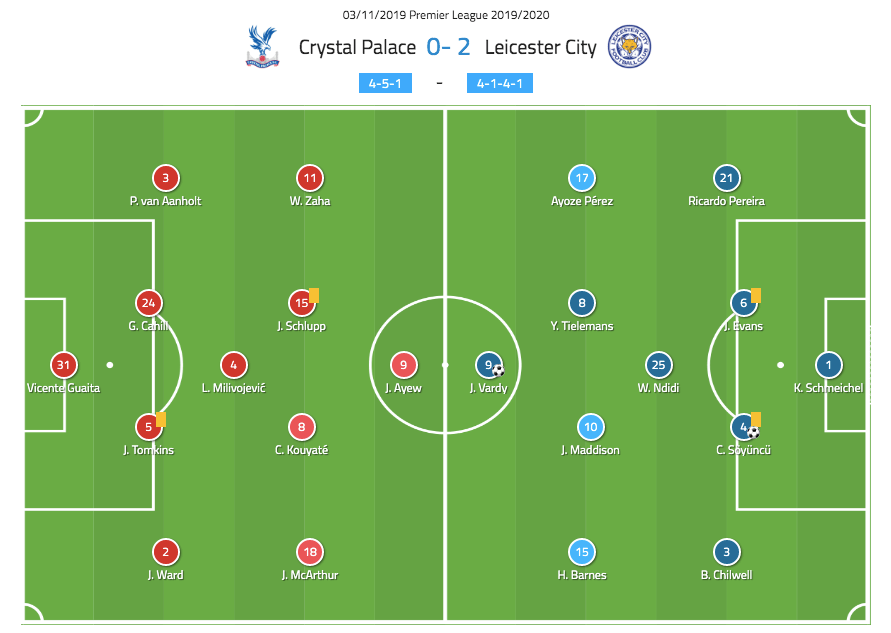
On paper, Hodgson chose 4–1–4–1 for his team in this game, but they practically shifted between 4–3–3 or 4–5–1 throughout the match. In the middle of the park, the trio of Cheikhou Kouyaté, Luka Milivojević, and Jeffrey Schlupp were chosen to control the midfield. In front of them, James McArthur was picked to partner Jordan Ayew and the talisman Wilfried Zaha as the Eagles’ offensive trio. Names like Max Meyer, James McCarthy, and former Liverpool striker Christian Benteke started the game from the bench.
In the opposite side, Rodgers opted for a 4–1–4–1 for his squad. The duo of Ricardo Pereira and Ben Chilwell were picked to be the full-back pairing. In front of the backline, Rodgers started Wilfried Ndidi to give more protection for the defensive department. Last week’s hat-trick heroes Jamie Vardy and Ayoze Pérez started up front alongside Harvey Barnes. The dugout then was filled by names like Wes Morgan, Demarai Gray, and Dennis Praet.
Palace’s solid defensive system: the attackers
In this part of the analysis, we’re going to see Palace’s defensive setup for the game. Off the ball, Hodgson initially set Palace in a 4–3–3. The focus in their 4–3–3 was to pack the central part of the pitch and force Leicester to play wide.
In that shape, the attackers were given different tasks. Ayew was instructed to keep his eyes to Ndidi and close the passing lane from Leicester’s centre-backs to the Nigerian. He did that by positioning himself in front of the midfielder so Ndidi couldn’t receive the ball.
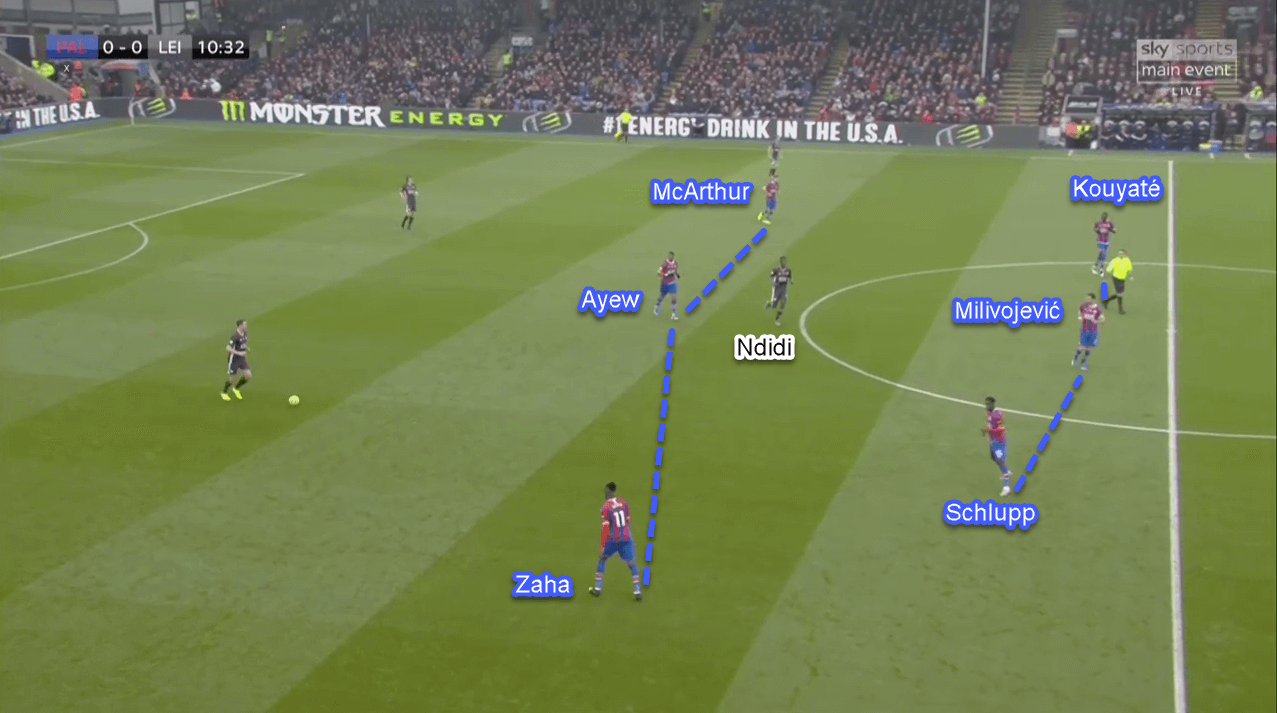
Next to Ayew, the wingers were given other defensive tasks. Both of them were positioned inside both half-spaces and were instructed to close passing lanes to the opponent’s full-backs. Not only that, when either one of Çağlar Söyüncü or Jonny Evans was holding the ball too long or making a heavy touch, one of the wingers would have to join Ayew up front to capitalise from the situation. The temporary front two then had to press the centre-backs to steal the ball or at least make them return the ball to Kasper Schmeichel.
Palace’s solid defensive system: the midfielders
Behind the attackers, Hodgson set his midfielders more defensively. He ordered his midfield trio to be very compact horizontally – with only about a 25-metre distance between Kouyaté and Schlupp.
The reason behind this was to prevent Leicester from building their attacks centrally and limit their attempts to reach Vardy quickly. By utilising a very compact midfield line, Palace were able to intercept the ball easier.
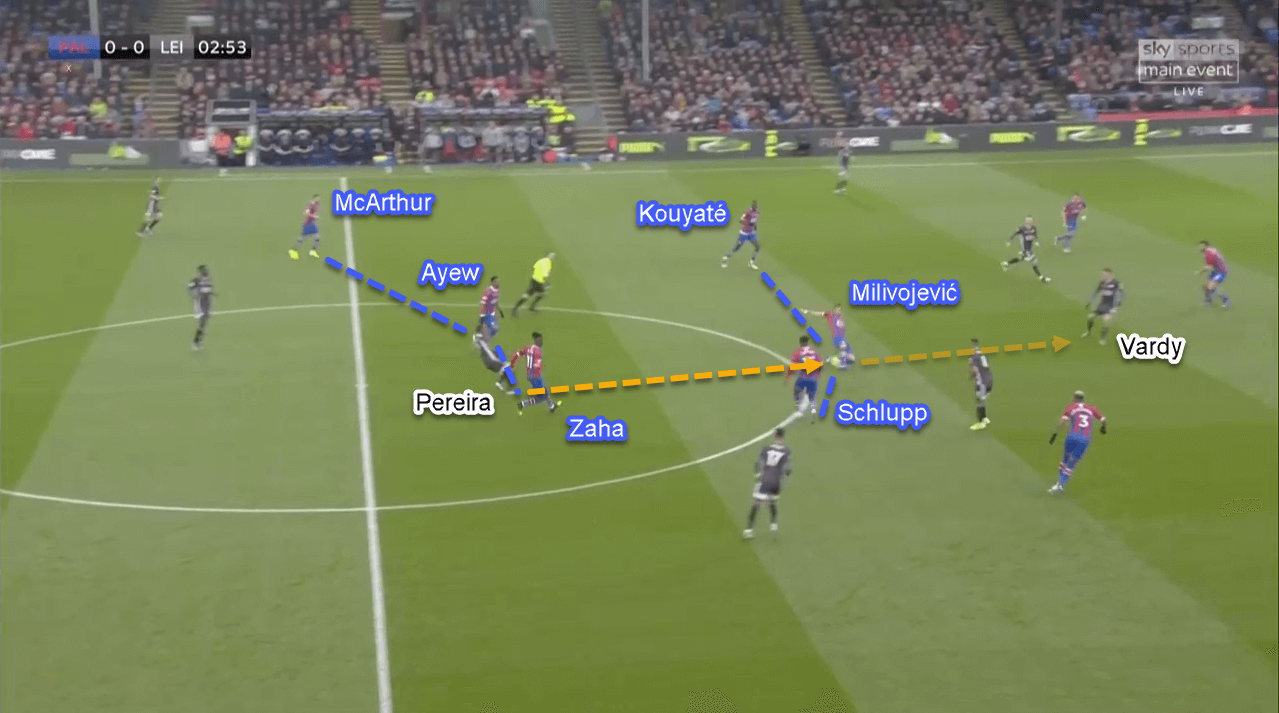
Facing a packed Palace’s defence, Rodgers instructed Youri Tielemans and/or James Maddison to drop alongside Ndidi in Leicester’s build-up phase. This dropping movement would help the on-ball centre-back to have more forward passing options so the visitors could progress the ball more smoothly.
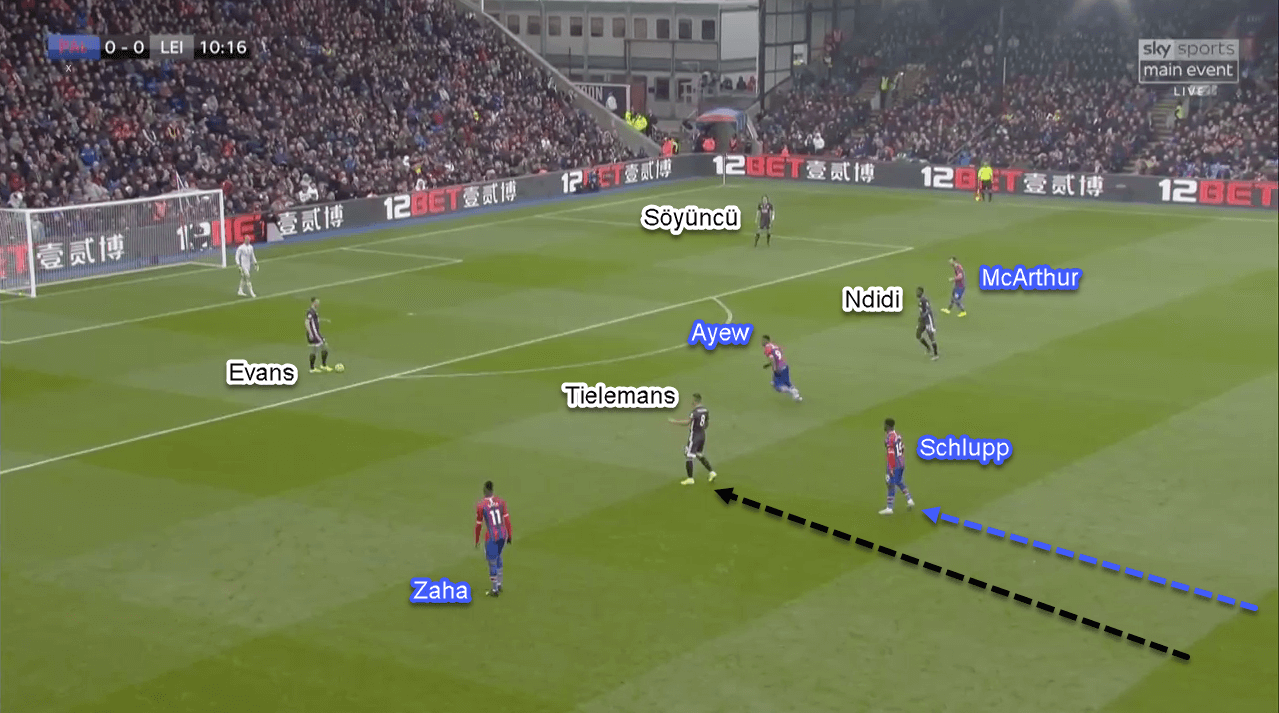
However, Hodgson reacted brilliantly to that. He would ask his nearest outside midfielder, either Kouyaté or Schlupp, to follow Maddison or Tielemans’ dropping movement respectively. The objective was to prevent Leicester’s offensive midfielder(s) from receiving and progressing the ball. Meanwhile, behind the duo, Milivojević stayed put to keep the defensive structure.
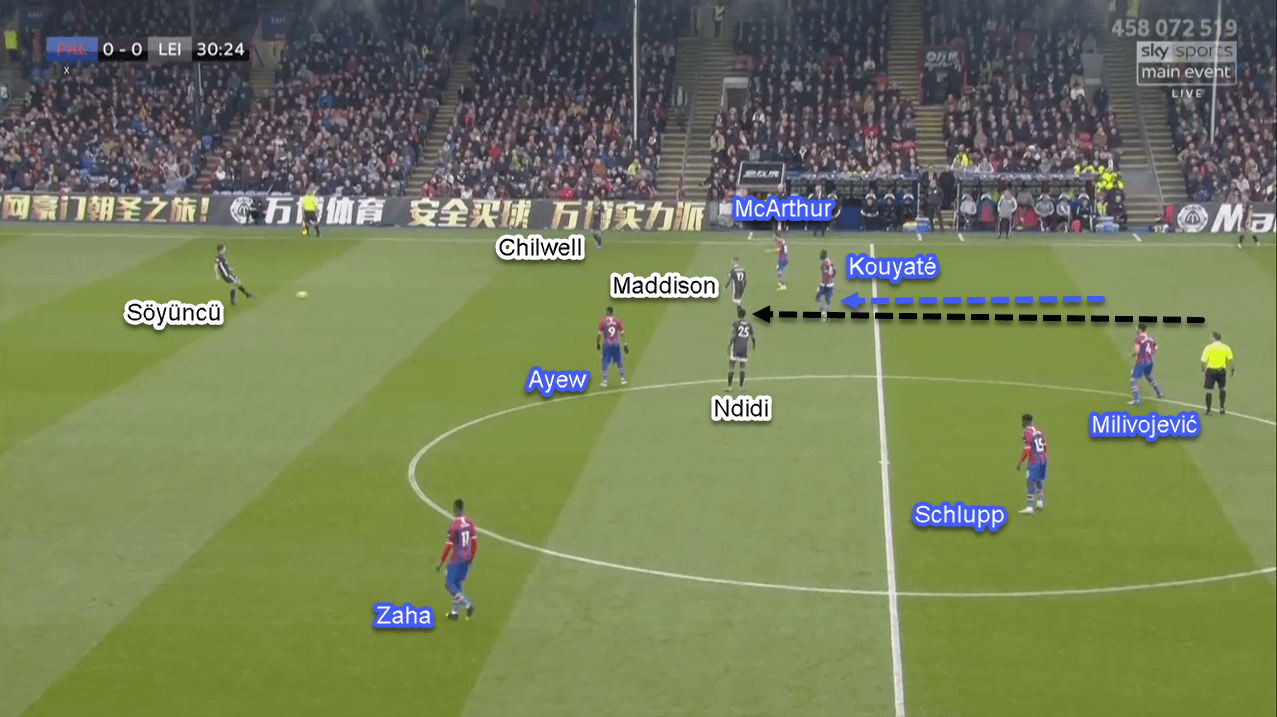
The Foxes exploited the small gap to progress the ball
As mentioned before, Palace’s attackers had multiple defensive responsibilities to contain Leicester’s build-ups. Not only to close forward passing lanes to Ndidi and the full-backs, but they also had to press the ball simultaneously when the situation arose. This complicated defensive tasks and would sometimes make them uncoordinated, thus allowing Leicester to bring the ball forward.
One of the reason was the Palace wingers’ miscalculation to join Ayew and press the visitors’ centre-backs. By getting a bit too aggressive in the wrong moment, the pressing winger would open the passing lane for Leicester’s full-back who he had to cover. The passing lane then would be exploited by Schmeichel or the on-ball defender to make a diagonal pass for the ball-far full-back.
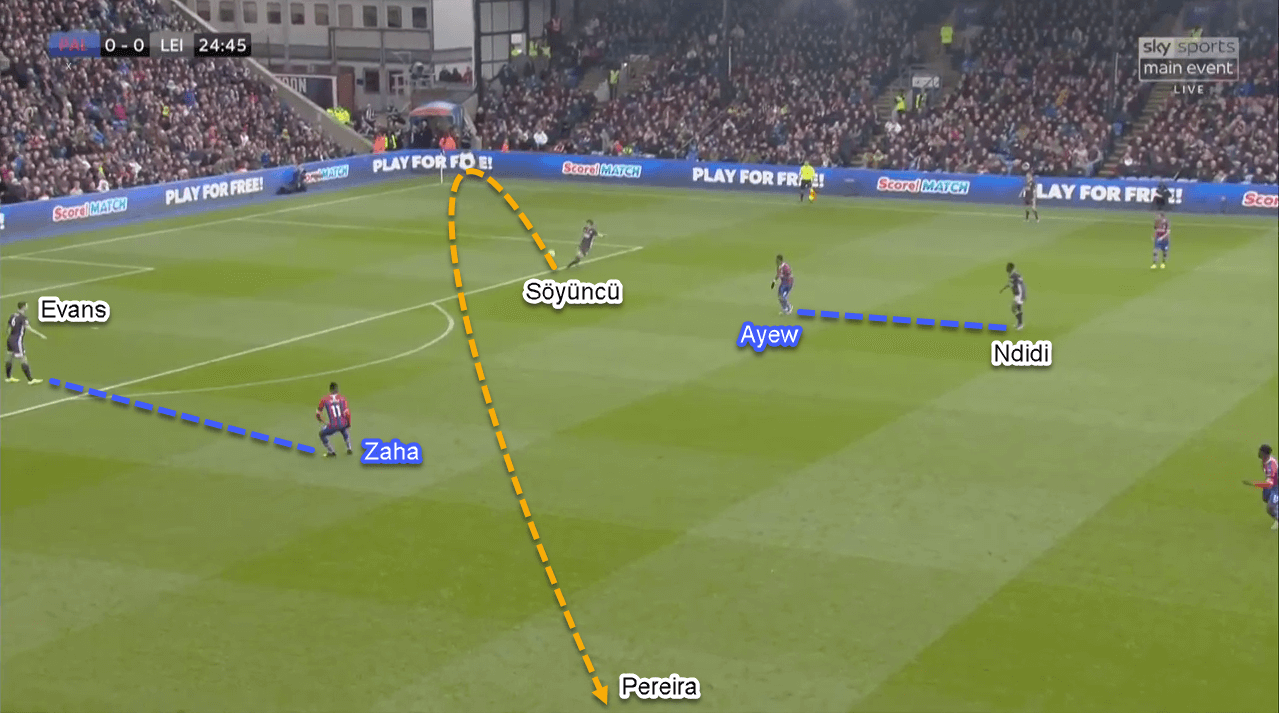
Another reason was Ndidi’s smart movement to get off from Ayew’s coverage. Knowing the Ghanaian had several defensive duties, which were to cover Ndidi while also keeping an eye on the ball, the Nigerian international sometimes could drift away and offer himself inside the half-space. With enough space and time on the ball, the defensive midfielder could give the ball to the nearest full-back and help Leicester in bringing the ball forward.
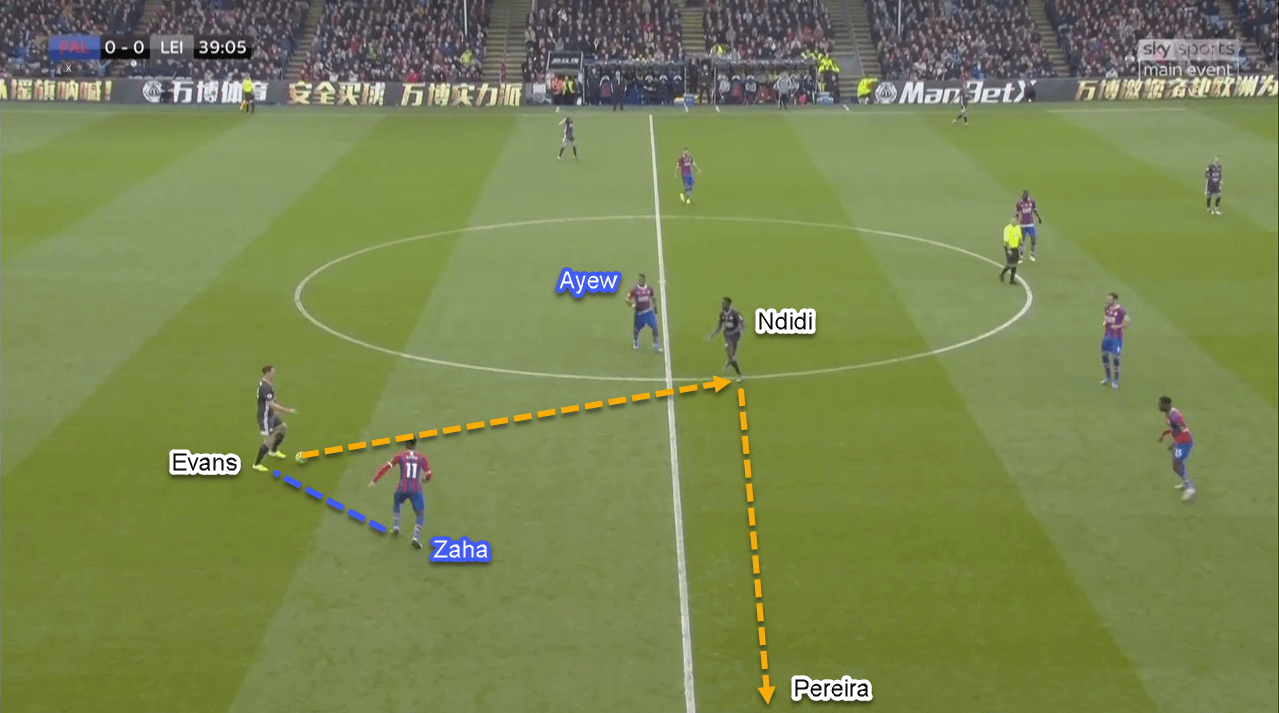
Palace’s ball-side midfielder could not cover the pressing winger or Ayew due to his marking on Leicester’s offensive midfielders. Behind him, Palace’s ball-near full-back was also unavailable because of the similar task to mark the Foxes’ winger.
Shifting structure, same solidity
When their first pressing line got bypassed, Palace remained calm. In their part of the pitch, they would make a shift to 4–5–1 with their wingers going back and tucking themselves in the flanks, next to the midfielders.
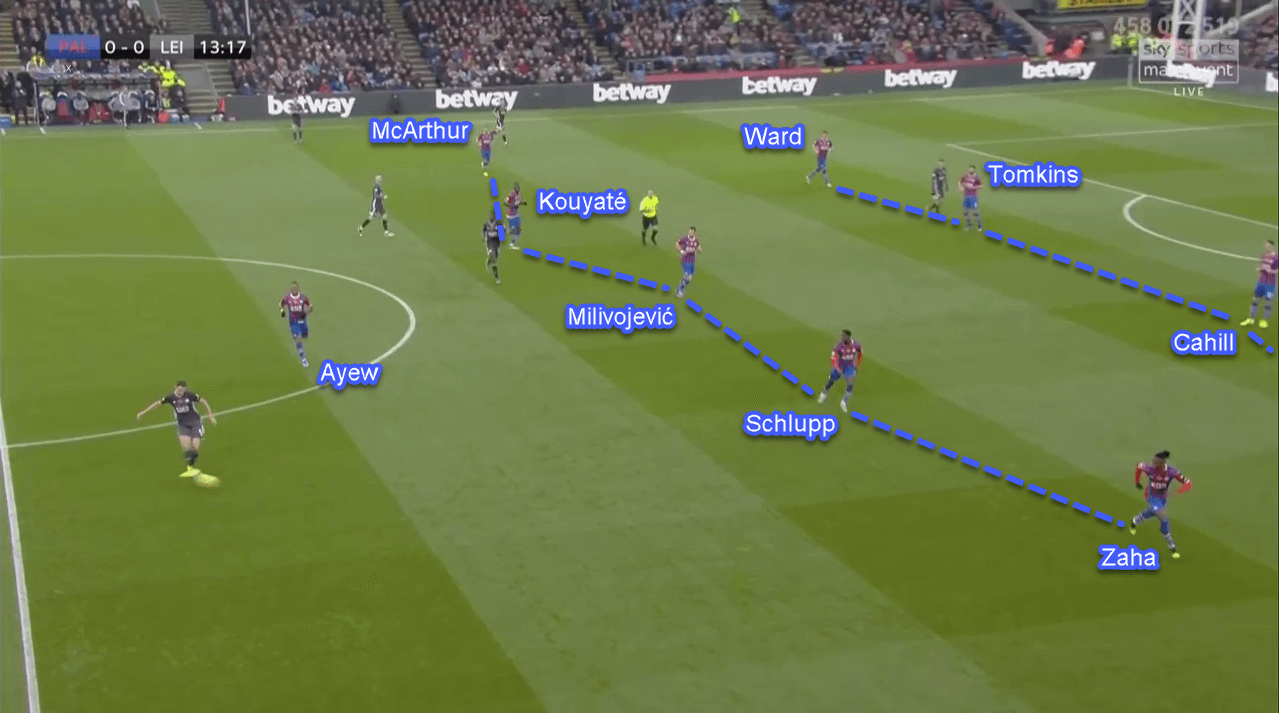
Playing through the flanks, Leicester would use three players to bring the ball into the final third. In the 4–5–1, Palace would have at least four players to defend in that situation. These four players consisted of a winger, a midfielder, a full-back, and a centre-back; all ball-near side.
The quartet would make a square in the area where the ball was being played with two wide players and two more inside the half-space. In that square shape, they were compact vertically and horizontally – therefore making them hard to penetrate.
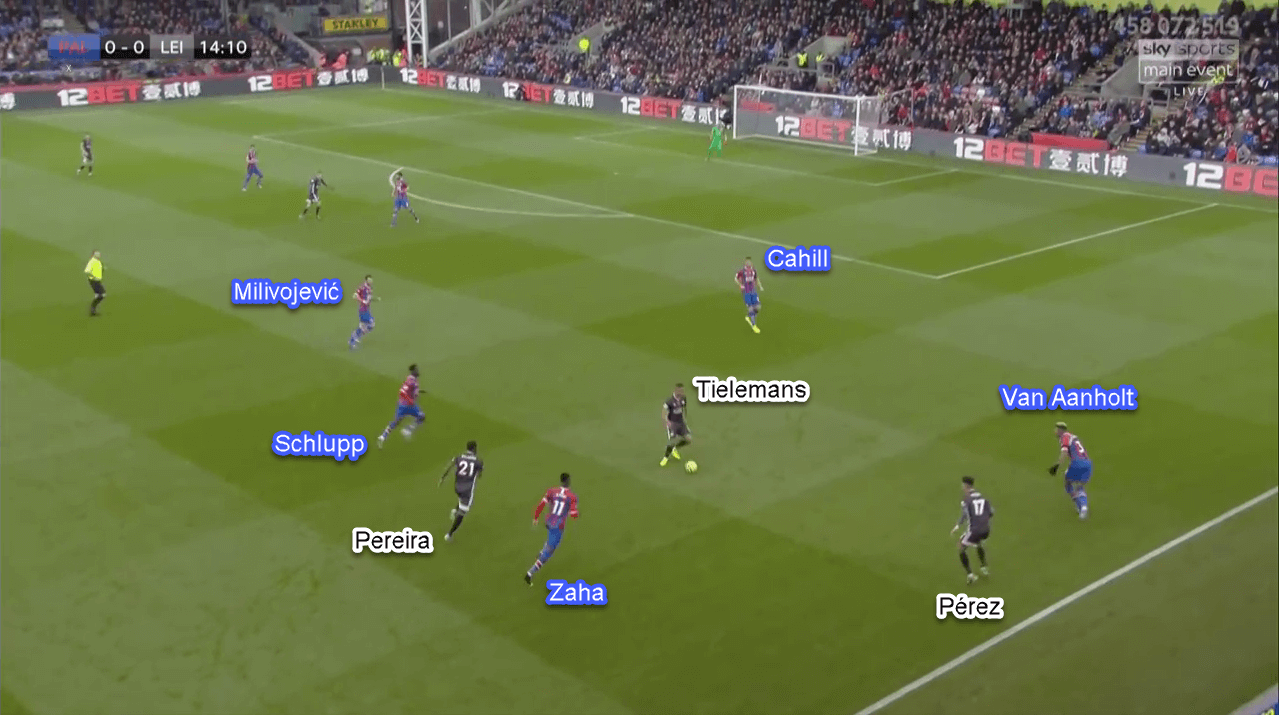
With four players against Leicester’s three, Palace would have the numerical advantage if they got attacked from the flank. On top of that, Milivojević would provide a back-up if somehow Leicester managed to go through.
Another advantage the home side had was if they could steal the ball. With four players to three, the Eagles had one extra player to progress the ball and initiate their transitional attacks.
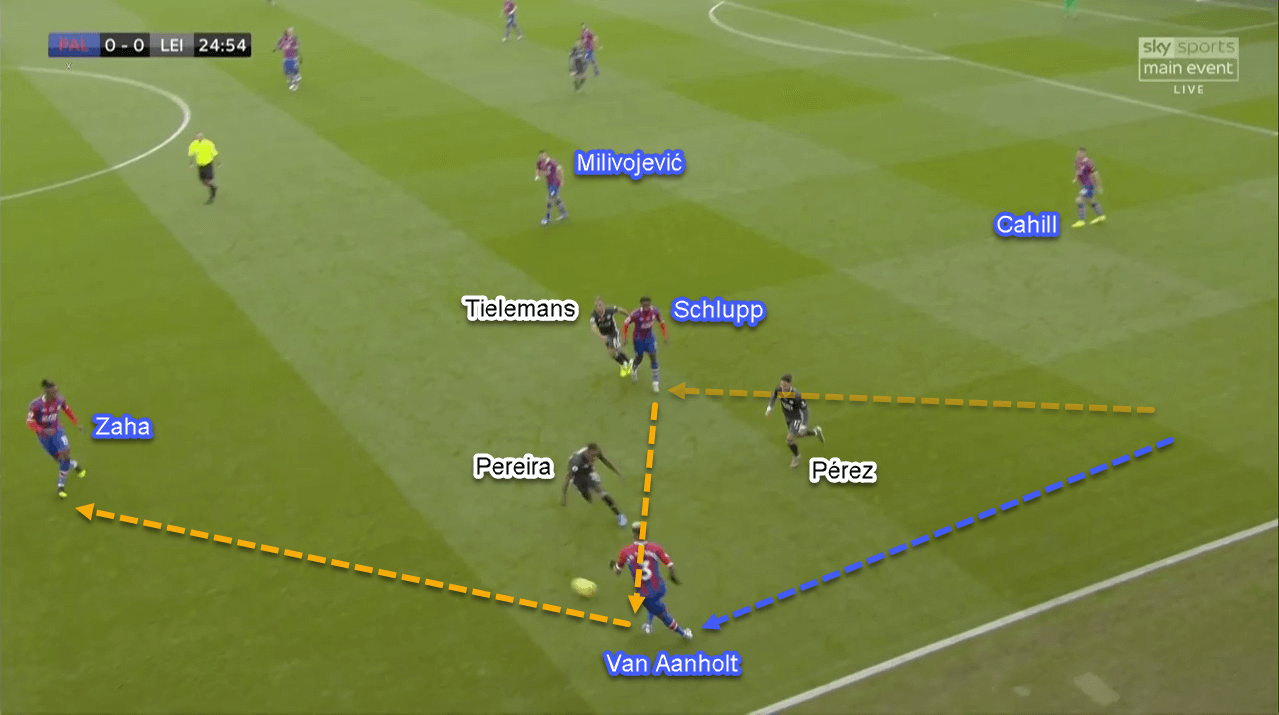
Dying from dead-balls
While brilliantly managed to limit Leicester’s open-play attempts to only three, Crystal Palace did the opposite in set-piece situations, where they conceded ten shots throughout the game. One of them resulted in Söyüncü’s goal, which changed the course of the game.
In defending corners, Palace would use a hybrid of zonal and man-to-man marking. Two players were tasked to mark zonally while the others marked their opponents inside the box. Those two zonal players were Kouyaté, at the near-post, and Patrick van Aanholt, in the edge of the box. They had the task to clear the ball if it came to their respective areas.
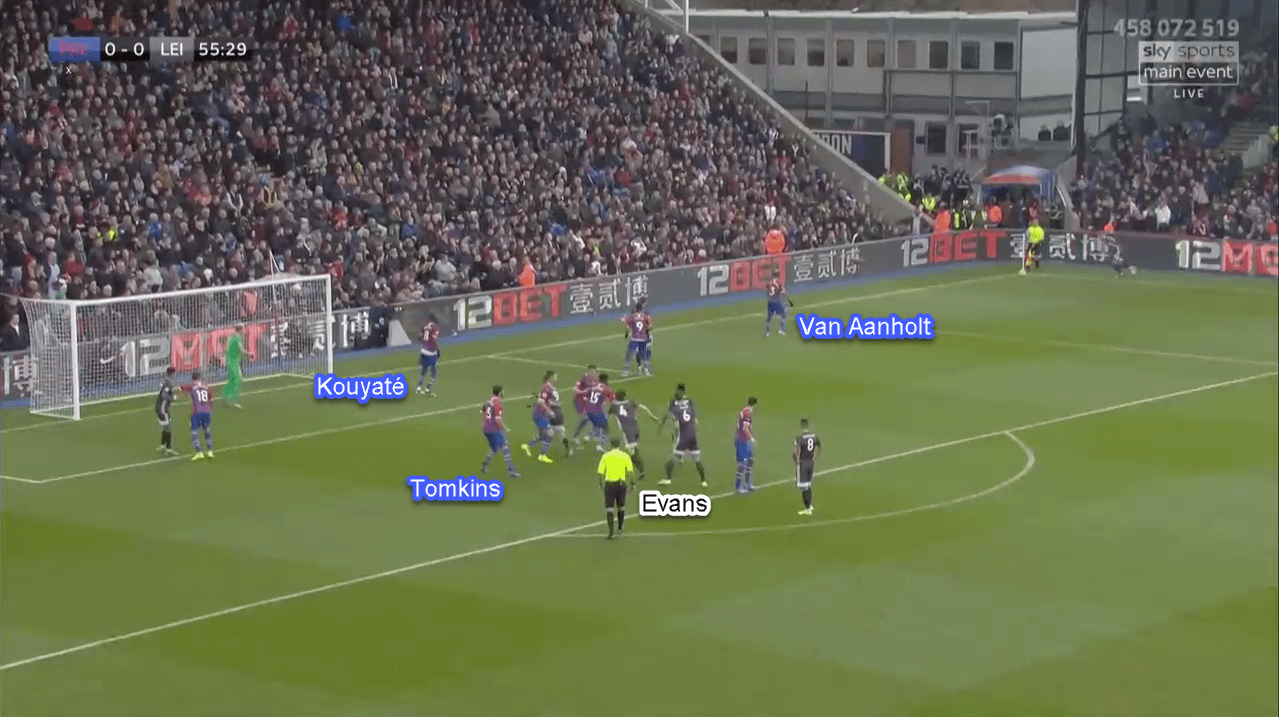
One recurring issue from Palace’s defensive setup in defending set-pieces, especially corner-kicks, was their defenders’ lack of discipline in marking their opponents near the penalty spot. From the four defenders they put there, only two or three who would tightly mark their respective opponent, the remaining ones would give enough freedom for Leicester’s potential header(s) to move and attack the ball.
In the image above, James Tomkins allowed Evans a huge space to move. The Northern Irish defender then used the space to gain momentum before attacking Maddison’s cross. It was only Vicente Guaita’s superb save that prevented the scoreline to change. It didn’t last long, though.
Söyüncü punished the errors
After Evans’ saved attempt, Leicester were awarded another corner-kick. As mentioned above, two Palace players were tasked to defend zonally in corner-kick situations, with both of them having different areas to cover.
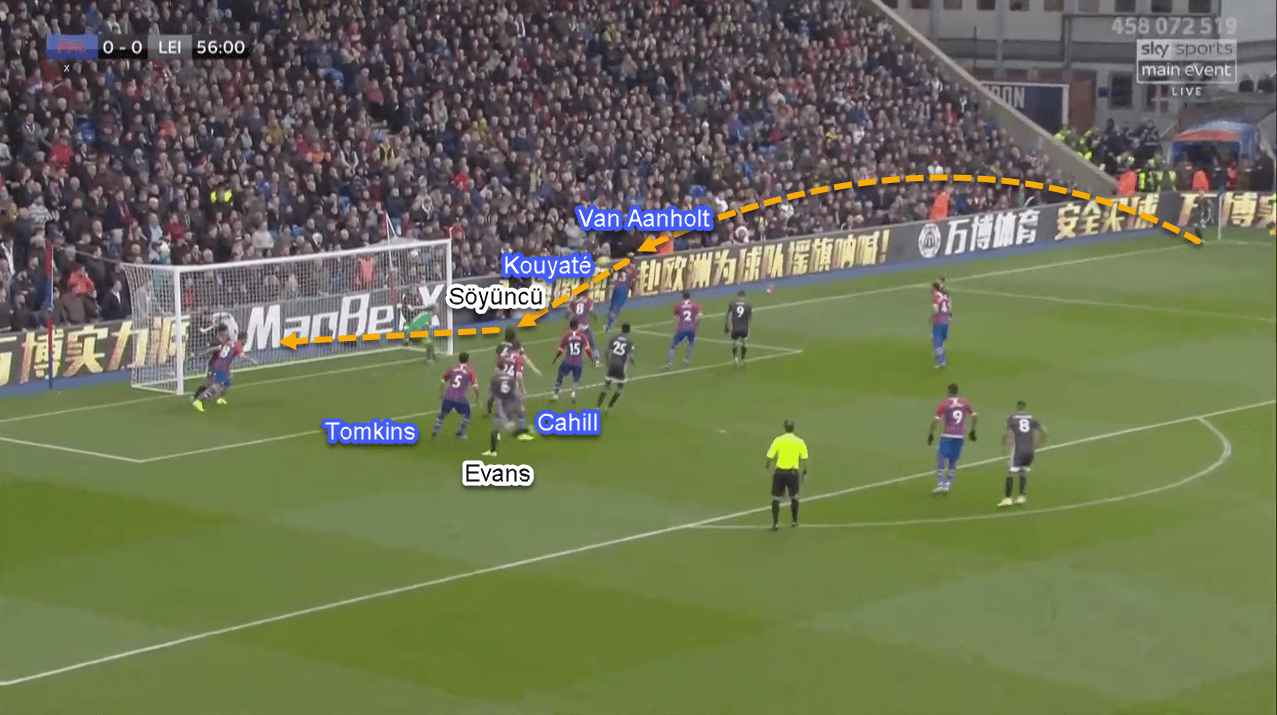
However, Van Aanholt decided to drop to the near post and come to Kouyaté’s area. After made his dropping movement, he tried to clear the ball ahead of his teammate. This decision backfired massively as the ball reached the goalmouth because he couldn’t make proper contact with the ball.
By the time Van Aanholt was trying to get into the ball, Söyüncü and Evans made their runs to attack the ball, when both should be tightly marked by Gary Cahill and Tomkins respectively. However, the Palace pair were caught ball watching and again allowed their opponents time and space to attack the ball. Söyüncü, completely free from Cahill, then attacked the loose ball to make it 0–1.
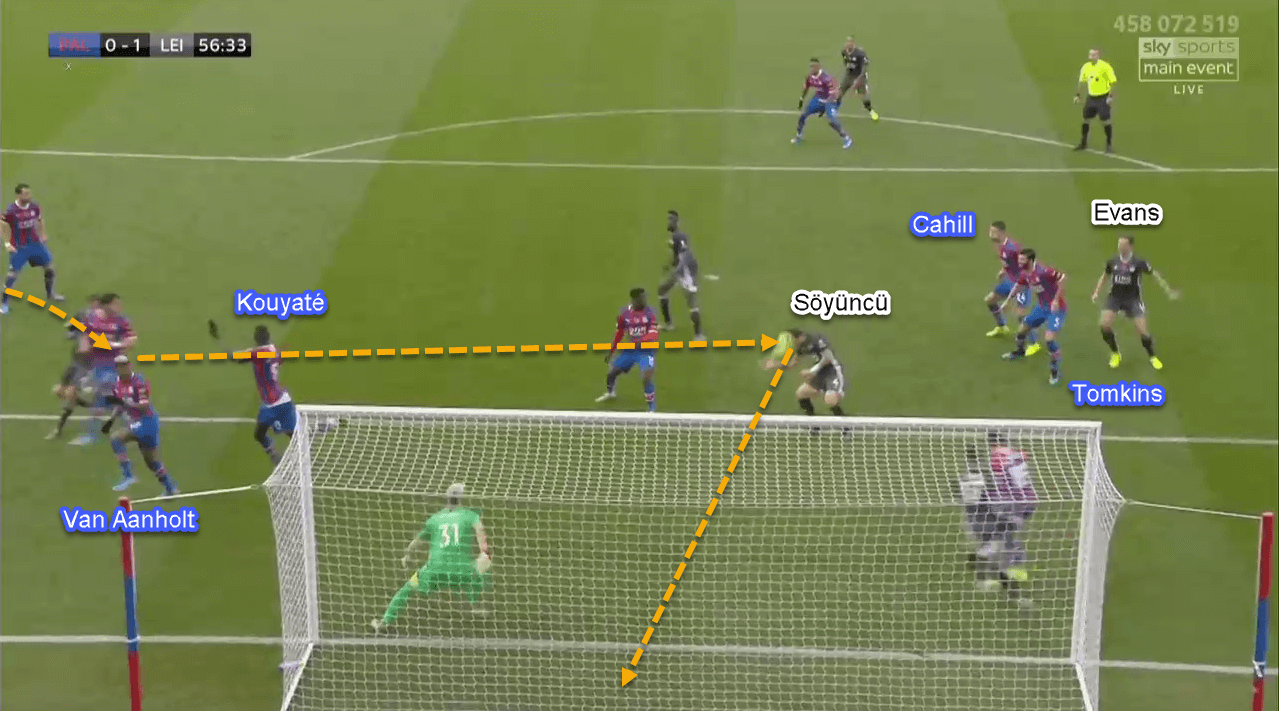
Conclusion
For almost an hour, Palace were able to show a dominant defensive display to keep the Foxes quiet, especially in open play situations. Ironically, one defensive mistake after another in dead-ball situations was the main cause of their agonising home defeat.
In the opposite side, Leicester’s relentless aggression cemented their place even stronger in the top four. On top of that, talisman Vardy now has 10 league goals to his name – the first player to do so this season. The last time he achieved that feat was back in 2016 when Leicester went on to win the league. Will they do the impossible once again? Let’s wait and see.

If you love tactical analysis, then you’ll love the digital magazines from totalfootballanalysis.com – a guaranteed 100+ pages of pure tactical analysis covering topics from the Premier League, Serie A, La Liga, Bundesliga and many, many more. Buy your copy of the October issue for just ₤4.99 here





Comments